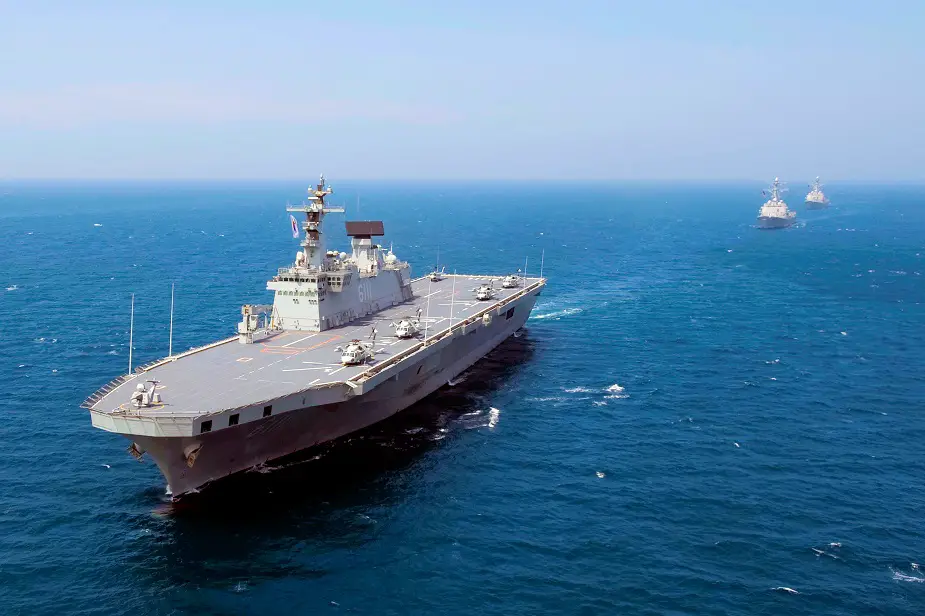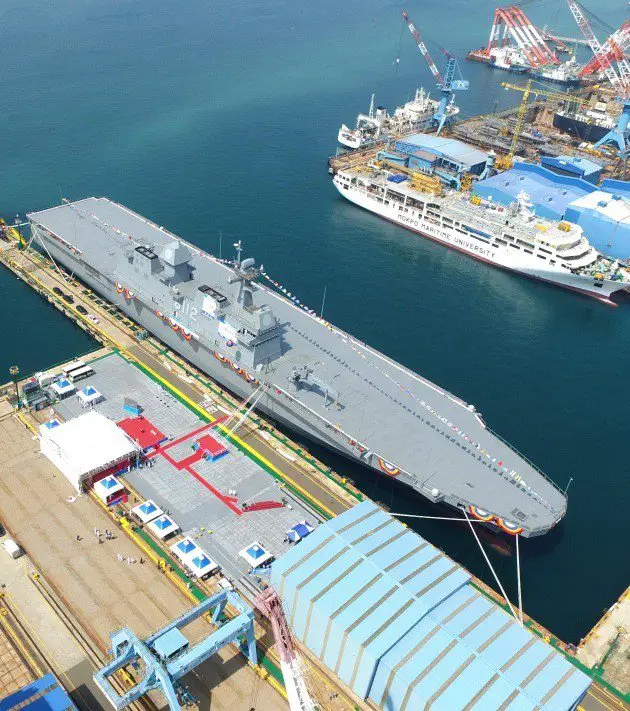Breaking news
ROK Navy Considers Adapting Dodko-class LPH for F-35B Aircraft.
The Republic of Korea Navy (ROK Navy) is looking to adapt its two Dokdo-class LPHs to deploy the F-35B STOVL aircraft. According to Yonhap News Agency, the ROK Navy issued a public notice of tender through an electronic defense procurement system of South Korea's Defense Acquisition Program Administration (DAPA), citing moves by neighboring countries to consider running F-38Bs aboard their vessels.
 The Republic of Korea Navy amphibious landing ship ROKS Dokdo (LPH 6111) underway in the Sea of Japan in 2010 with the guided-missile destroyers USS Lassen (DDG 82) and USS Chung-Hoon (DDG 93). (U.S. Navy photo by Mass Communication Specialist 3rd Class Adam K. Thomas/Released)
The Republic of Korea Navy amphibious landing ship ROKS Dokdo (LPH 6111) underway in the Sea of Japan in 2010 with the guided-missile destroyers USS Lassen (DDG 82) and USS Chung-Hoon (DDG 93). (U.S. Navy photo by Mass Communication Specialist 3rd Class Adam K. Thomas/Released)
The tender calls for a research project to explore the possibility of operating F-35B stealth aircraft aboard its amphibious landing ship following some modifications.
The ROK Navy has two Dokdo-class amphibious assault ships: ROKS Dokdo lunched in July 2005 and commissioned in July 2007 and ROKS Marado which was launched in May this year and is set to be commissioned in 2020. Both were built by local shipyard Hanjin Heavy Industries and Construction (HHIC) in Busan.
In October 2010, South Korean parliament decided on the construction of the second LPH and after a series of new deferrals on government decisions, on December 23, 2014, DAPA signed a contract with HHIC worth 417.5 billion won (about 380 million dollars) for the construction of this ship. HHIC completed the technical design review of the ship in March 2016 and cut the first steel in November 2016. Marado's keel was laid on April 28, 2017.
Video on Marado
Marado and Dokdo have a length of 199 meters, a width of 31 meters for a displacement of 14,500 tons . Their maximum speed is 23 knots, their range range is 10,000 nm at 18 knots. The crew complement is 300 sailors.
The second vessel features several improvements. “The Marado is basically similar to the Dokdo, but equipped with improved equipment and an improved system,” a DAPA official said during the launch ceremony.
Dokdo payload capacity is: Up to 720 fully equipped marines, 10 tanks, 10 trucks, 7 AAVs, 3 artillery systems. Well-deck has capacity for 2 LCU type landing craft or 2 Landing Craft Air Cushion (LCAC). All types of vehicles (Jeeps, IFV, MBTs, APCs, Engineering) as well as soldiers can be loaded into landing craft inside the well-deck and taken to shore. Below deck hangar capacities for up to 15 helicopters (including some V-22 for the Marado). Flight deck to accommodate simultaneously up to 5 helicopters of all types in service with NATO.
One major difference is that Marado's flight deck has been adapted to accomodate the Bell Boeing V-22 Osprey tilt rotor aircraft. Several DAPA images show the Osprey on the flight deck. For this reason, and the fact that vessel is still at fitting out stage, Marado would probably require less time, work and budget to be converted for F-35B operation.
According to DAPA, Marado is fitted with new navigation radar, infra-red sensors and fixed panel 3D surveillance radar (in place of the Thales SMART-L 3D radar fitted aboard the Dokdo), all developed in South Korea. The ROK Navy also mentioned a new anti-ship missile defense (likely LIG Nex1 SAAM). "Domestic weapon systems such as navigation radar, anti-missile defense system, and improved combat system will be installed in Korea, and anti-aircraft detection capability is also improved by installing a fixed air defense radar. In addition, major equipment and facilities such as propellers and lifts are also localized, which will improve maintenance and reduce maintenance costs." says the (translated) press release. Based on DAPA images, Marado appears to be fitted with two Phalanx CIWS: one at the bow and one at the stern. Marado is also fitted with the improved K-DAGAIE MK2 NG decoy launcher and SEALEM / SEALIR new generation decoys by Lacroix.
Regarding the F-35 Joint Strike Fighter, the Republic of Korea Air Force (ROKAF) originally ordered 40 F-35A while a further 20 were ordered in December 2017. No order has been place yet for the F-35B short take off vertical landing (STOVL) variant however. The first ROKAF F-35A was rolled out in March this year.
 The second Landing Platform Helicopter (LPH) amphibious assault ship 'Marado' of the ROK Navy during its launch ceremony. DAPA picture
The second Landing Platform Helicopter (LPH) amphibious assault ship 'Marado' of the ROK Navy during its launch ceremony. DAPA picture
Comments by Collin Koh, South East Asia Maritime Security expert
This plan had been floated earlier. But Japan has thus far been more vocal about it and apparently has got a much more developed plan in this regard. There's a chance Seoul has been secretly looking into this feasibility but had tried to desist from it as it observes the regional situation. I'll see this latest move as of course in part motivated by Japan's own plans to do the same, but also to do with the Korean Peninsula.
On the later point, allow me to elaborate. It'll seem counter-intuitive that given the easing of Korean Peninsula tensions, Seoul would go to this length, especially since there're recent confidence-building measures struck with DPRK. The issue here is that there're concerns within the country about whether the Moon Administration might roll back on earlier plans to bolster defenses in the face of persistent NK threat. So this is a likely form of hedging, also to assure the South Korean public that the administration remains resolved to enhance deterrence and defense despite the detente on the peninsula.
If you had watched what's going on in South Korea these days, it appears that the initial euphoria over the first Kim-Moon summit, and then Kim-Trump summit, has lost steam. There're now more questions about whether these high-profile events would really push DPRK towards eventual denuclearization. And there're now obvious indications that even if this eventuality does come, it'll take a long time to materialize - if at all. So it's prudent on the part of the ROK military to continue to bolster defenses. And this of course all ties in with the Defense Reform plan.
In any case, I suppose the ROKN program will still have to go on because there's an economic incentive to that. ROK shipbuilding isn't going through the smoothest days and ROKN state defense orders will be most welcome. If ROKN scales back on its programs, it'll affect these domestic shipbuilders. Though of course, they can at least still expect the promised contracts to continue.
Collin Koh is a research fellow at the Maritime Security Programme, S. Rajaratnam School of International Studies in Singapore.


























